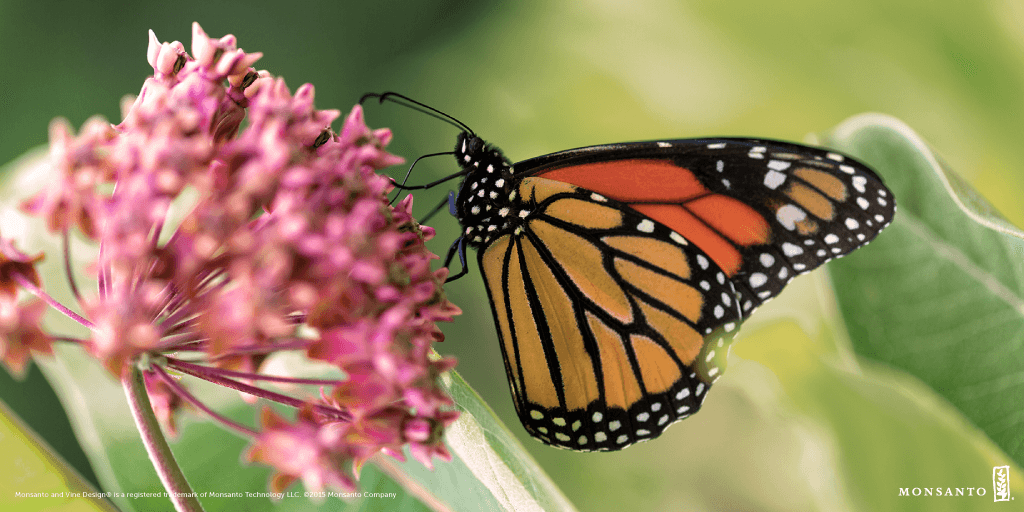Stories | January 11, 2017 | Read Time: 4 minutes
Monarchs: We All Have a Role to Play


In 2016, the monarch butterfly population had a sharp increase in its population that overwinters in Mexico. This is a good sign that conservation efforts to help the monarch butterfly – which include planting milkweeds and providing quality habitats –have had a positive effect on their population and migration.
However, in March 2016, a major winter storm (rain, hail, snow) and freezing temperatures swept across the area in Mexico where the monarchs hibernate in winter, and it took its toll on the butterflies that remained. We will not fully know the impacts that this storm, along with other unfavorable climatic conditions along the migration route, until next winter; so far, monarch sightings by Journey North and the Monarch Larva Monitoring Project this summer have been lower and signal monarch numbers may decrease.
A resilient monarch population has to be large enough to absorb big losses in bad years and have sufficient breeding habitat to recover in good years. Monarchs face threats from extremes of weather, predators, pathogens, parasites, pesticide overspray, and even climate change. All of these factors contribute to declines in the monarch population.
Over the past 20 years, the number of milkweeds available for monarchs to breed has declined. There are a lot of factors contributing to this: a reduction in conservation land; improved weed management in crop fields; and changes in agronomic (farming) practices – many with the overall goal of making farming more sustainable – all of which contribute to fewer milkweeds in crop fields, field margins, and fence rows.
Fortunately, the monarch is a resilient species, and it is capable of rebounding so long as there is adequate habitat and favorable conditions for monarchs to breed. That makes what we are doing to expand, enhance, and protect their habitats that much more important. The storms in March are a wake-up call to remind us that building the capacity for monarchs to recover and expand their numbers is a priority.
In March 2015, Monsanto committed $3.6 million over three years to the National Fish and Wildlife Foundation’s (NFWF) Monarch Butterfly Conservation Fund. Through this partnership with NFWF and several other federal agencies, the Fund awarded $3.3 million to 23 projects in August 2015 to create more than half a billion milkweeds and other nectar plants and restore more than 33,000 acres of monarch habitat to support a resilient monarch population and migration.
In August 2016, the Monarch Butterfly Conservation Fund awarded an additional $3 million for 22 projects that will enable habitat conservation, restoration, and improved land management practices; enhance coordination and capacity of monarch butterfly conservation efforts; and improve the seed supply of milkweeds and other nectar-producing plants.
As a member of the Monarch Collaborative and other initiatives like the Iowa Monarch Conservation Consortium, Monsanto helps create greater awareness of the need for monarch habitat within agriculture, shares our knowledge and experience and provides funding as a catalyst for on-the-ground action.
Monsanto is a founding member of the Monarch Collaborative, a joint effort of academia, business, farmer groups and federal and state governments organized to support expand and enhance habitat for a sustainable monarch population. We support financially and participate in the Iowa Monarch Conservation Consortium, Missourians for Monarchs Collaborative, and Sand County Foundation’s Monarch/Pollinator Conservation, all of which are dedicated to helping monarchs thrive.
In 2015 and 2016, Monsanto made available to Monarch Watch in total 200,000 milkweeds for restoration projects free of charge for planting into landscapes where quality habitat is needed. Additionally, Monsanto’s involvement with Pheasants Forever has helped establish habitats at 70 of our sites from Texas to Minnesota with the goal of supporting monarch recovery.
Farmers, who are traditional stewards of the land, also have a role to play in helping monarch populations grow and thrive, and Monsanto encourages them to use agricultural practices that expand, enhance, and protect milkweed on non-crop areas. Milkweeds growing in a crop field can compete with crops for sunlight, water, and nutrients; but when milkweeds are growing outside of productive crop fields, restoring monarch habitat and increasing farmers’ harvests can be compatible goals.
There are other organizations, agricultural groups, government agencies, and more that are working to improve conditions for monarch butterflies. Monsanto acknowledges the commitment and work done by so many. The combined efforts of these are making a difference.
You can help, too, by planting milkweeds and nectar plants where we live, work, and play, so that monarchs can find suitable habitat in all places – be it urban, suburban, or rural. Let’s work together to strengthen the population of this beautiful, iconic butterfly.









